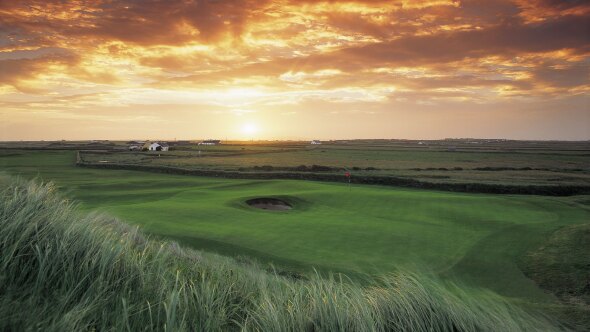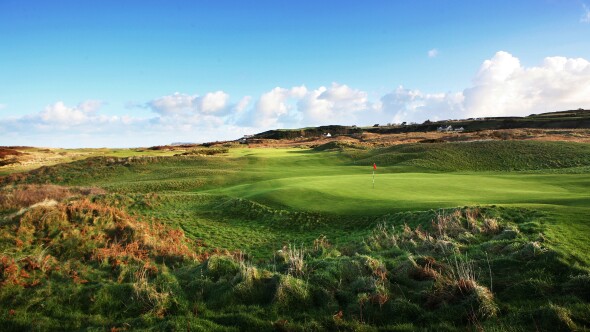Tralee Golf Club

About
| Tee | Par | Length | Rating | Slope |
|---|---|---|---|---|
| Blue | 72 | 6991 yards | ||
| White | 72 | 6681 yards | ||
| Green | 72 | 6247 yards | ||
| Red | 72 | 5481 yards |
| Hole | 1 | 2 | 3 | 4 | 5 | 6 | 7 | 8 | 9 | Out | 10 | 11 | 12 | 13 | 14 | 15 | 16 | 17 | 18 | In | Total |
|---|---|---|---|---|---|---|---|---|---|---|---|---|---|---|---|---|---|---|---|---|---|
| Blue M: 73.6/135 | 404 | 596 | 194 | 426 | 430 | 427 | 157 | 399 | 504 | 3537 | 474 | 595 | 461 | 159 | 483 | 310 | 199 | 317 | 486 | 3484 | 7021 |
| White M: 72.3/128 | 390 | 588 | 158 | 402 | 411 | 421 | 148 | 391 | 495 | 3404 | 418 | 565 | 440 | 152 | 397 | 293 | 182 | 351 | 479 | 3277 | 6681 |
| Green M: 70.5/126 | 369 | 544 | 145 | 379 | 388 | 390 | 126 | 359 | 462 | 3162 | 403 | 548 | 422 | 130 | 398 | 267 | 138 | 337 | 452 | 3095 | 6257 |
| Red W: 73.3/131 | 351 | 386 | 126 | 386 | 331 | 339 | 124 | 380 | 446 | 2869 | 342 | 456 | 373 | 103 | 262 | 233 | 119 | 395 | 401 | 2684 | 5553 |
| Handicap | 14 | 2 | 12 | 6 | 8 | 10 | 16 | 4 | 18 | 7 | 5 | 1 | 15 | 13 | 11 | 9 | 3 | 17 | |||
| Par | 4 | 5 | 3 | 4 | 4 | 4 | 3 | 4 | 5 | 36 | 4 | 5 | 4 | 3 | 4 | 4 | 3 | 4 | 5 | 36 | 72 |
| Handicap (W) | 6 | 2 | 16 | 14 | 12 | 4 | 18 | 8 | 10 | 3 | 7 | 1 | 17 | 15 | 9 | 13 | 5 | 11 |
Course Details
Rentals/Services
Practice/Instruction
Policies
Food & Beverage
Bar, RestaurantAvailable Facilities
Clubhouse, Internet AccessReviews
Reviewer Photos
-
Photo submitted by BrandonWebb on 08/06/2022
-
Photo submitted by BrandonWebb on 08/06/2022
-
Photo submitted by BrandonWebb on 08/06/2022
-
Photo submitted by BrandonWebb on 08/06/2022
-
Tralee Golf Club - hole 2 Photo submitted by TimGavrichGP on 09/21/2018
-
Tralee Golf Club - hole 16 Photo submitted by TimGavrichGP on 09/21/2018
Could only manage a few photos today between squalls. Bit of a slog as we played in an absolute downpour all day. Can’t remember playing in nastier conditions. We pulled the rain suits out and put the scorecard away. Just tried to play some cool golf shots in maniacal wind and steady rain. Some days it’s not about what you shoot, or how you played - but that you even played at all.
Even in poor conditions, it is easy to decipher why Tralee has such a fine reputation. The front nine, designed by Arnold Palmer, suffers only because the sister nine “was designed by God.” The outward nine is no slouch with standout cape holes and the stellar par-3 third. The inward half is ruggedly natural and playing the final few holes through the massive dunes alongside the ocean were worth leaving soaked to the bone.
Dramatic dunes make for memorable golf
Though Ireland, like Scotland, is a golf destination where visitors tend to focus on the ancient links, Tralee is a modern course (built in the 1980s) that embraces much of what makes the much older courses memorable.
It's a fairly simple setup: a nice clubhouse (including great showers in the locker room, which came in handy after a cold, wet round) and a memorable golf course that takes advantage of some of Ireland's most dramatic dunes. Things really get crazy on the back nine, where the stretch from the 12th through the 17th features some one-of-a-kind shots. Tralee is a great spot for match play: embrace the challenge, accept that you might lose a couple golf balls and go have fun. You won't be sorry.
A Golfer's Golf Course
A late morning start at Tralee G.C. A course surrounded by the Atlantic with some of the most stunning beachscapes you will ever see from a golf course. Tralee was designed by Arnold Palmer who said he had never come across a piece of land so ideally suited for the building of a golf course and was happy we have one of the world's great links in Tralee.
The course has a welcoming opening hole with a generous fairway, downhill of moderate length. The second is a much tougher four with a drive that has to be carefully assessed as to how much of the corner you are willing to bite off.
The signature hole is the third that plays to 194 yards from the back tees and feeds down left to right. Depending on the wind it can take anything from a wedge to a three wood.
The eighth hole is a cracker dog leg left with another risk/reward drive to a fairway that wraps around the beach below. Bite off too much like me and you will be reloading. An uphill par five ends the nine.
The back nine is, in my opinion, almost as good as Ballybunion. It features reasonably hilly elevation changes on almost all holes and has great variety along with demanding shot lines. Ten is a long par four with the second played down then up to the green.
The eleventh is a tough uphill par five with a blind second and the twelfth is the toughest hole on the course with the green sitting high up for your second shot. Thirteen is short but all carry across a ravine and fourteen is the last really good birdie chance.
Fifteen is a fabulous short par four with a decision to be made on the drive strategy that then dictates the second shot to a steeply sloping green. The sixteenth is a superb par 3, a downhill 197 yard shot to a well guarded green and beach off the right.
The penultimate hole is another short four with a tough drive followed by a precise shot up to a green you cannot afford to be short to as it will feed all the way back down the fairway. The round finishes with another uphill par five to a large green below the clubhouse.
Tralee isn't often spoken about with some of the better known links courses but for mine is up there with the best we have played on the trip. A golfers golf course.
My Top course of all time!!!!!
Simply brilliant....
Could of only been better if was playing with Arnie himself.
The staff are wonderful.....this course represents Irish quality and friendliness.... to me it is a must play.
Great views, challenging golf.
Difficult course to get to, signage along the way is not the best. Worth the effort to get there and play the course. Would love to play it again someday.
Great views
This is a great course with very nice views of the water throughout the 18 holes.
Great scenery
The front is long but open; the back nine is long & tough; bring extra balls. The scenery on over half of the holes is awesome. Eugene the starter is very helpful
































Great course. Very challenging. One of the very best links courses in the world. Arnie did it again!